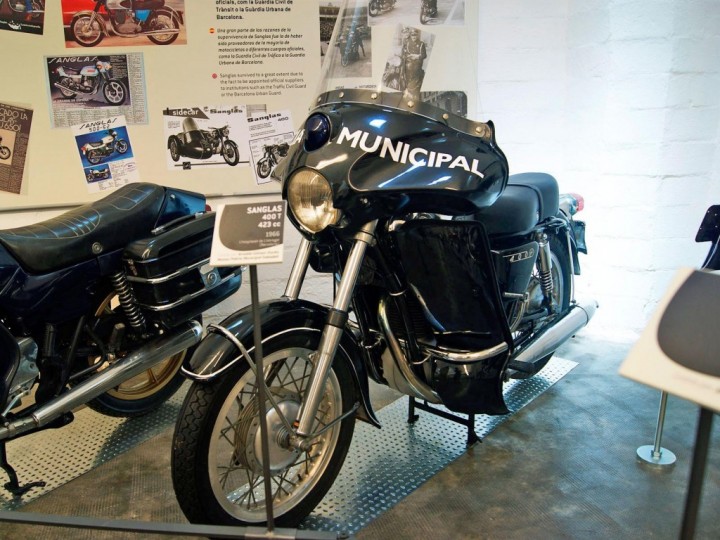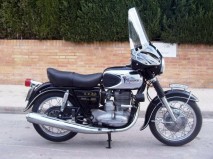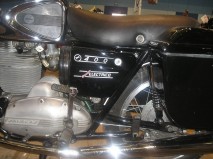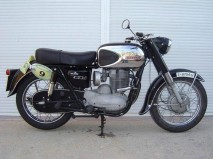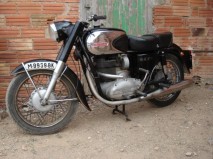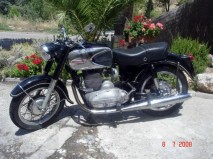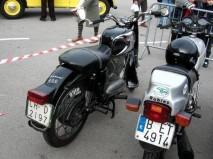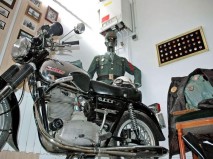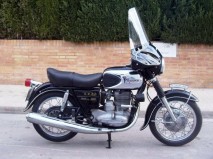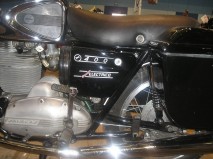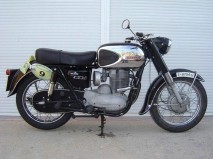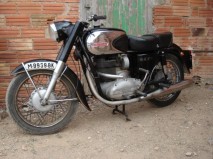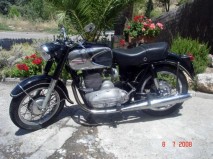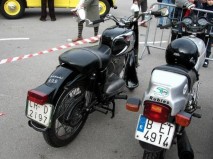1966 Sanglas 400T
L'Hospitalet de Llobregat (Barrcelona)
Arnaldo Gomez Duran , Museu Policia Municipal Sabadell
Sanglas was a Spanish motorcycle manufacturer which was founded in Barcelona (Poble Nou) in 1942 and ceased production in 1981.
Sanglas motorcycles were equipped with relatively large powerful engines for its time, especially for Spain. The company was born with the intention to position itself as an alternative to such brands as BMW, Zündapp or DKW to provide motor vehicles to official agencies.
The history of the brand dates back to 1942 three years after the Spanish Civil War, but the first documents on the formal sale of motorcycles date from 1947. The company was founded by two young students of engineering in Barcelona, the brothers Javier and Martin Sanglas with financial assistance of their father, a textile entrepreneur.
Sanglas models were a hybrid of English and German models. The chassis was based on the concept of BMW and the engine, type monoblock, 4-stroke single cylinder, OHV type, was inspired by DKW brand. The first motorcycle had a displacement of 347.75 cc. and 14.4 HP power at 4,800 rpm. At the end of 1948 the company already had 100 employees and had manufactured 200 units. The first model, 500 cc with a rear chassis renovated to be able to accommodate an oscillating fork and two hydraulic shock absorbers, was launched in October 1952.
The Sanglas were designed for tourism, reached considerable speeds and could travel long distances. 350/4 and 500/3 models included engines with increased power, an improved silencer and brakes in aluminum among other improvements. However, the Seat 600 car was only marginally more expensive than the Sanglas. In 1957 a motorcycle model with a sidecar made in fiberglass was presented at the Fair in Barcelona. A renewed version of the mountain motorcycle, named Montaña II afterwards, with substantial improvements over against the first version, was also launched. It yielded 25 HP with a high torque value.
In 1958 the production amounts to 500 units annually, which leads to expand production with the subsequent transfer from Poble Nou to a more modern factory located in El Hospitalet. During the crisis of those years the staff was reduced from 200 to 50 workers, many of them becoming suppliers and outsourcing manufacturers of some components, for example at producing new Sanglas 400 with British engines under the brand Rovena.
At the end of the 1950s, due to the production rise of four-wheeled vehicles, many motorcycle manufacturers were forced to reduce the cylinder displacement of their models. The result was the model known as “Chromática”, with 295 cc engine, 13 HP power and 6,000 rpm. In 1959 480 units were sold, 250 to public agencies and 230 to individual clients. The Chromática nickname was due to the four colors (blue, salmon, green and black) in which it was supplied.
A 500 cc model was launched in 1967 intended for military use, but did not receive much demand. In the same year, Sanglas launched the brand Rovena, with two-stroke two-cylinder Hispano Villiers engines and capacity of 250/350 cc (the latter since 1963). The production of the Sanglas with two-stroke Zündapp engines of 50, 75 and 100cc began in 1964. Four-stroke engine model 400T (423 cc, already designed in 1956-57) was presented at the Fair in Barcelona. This model would serve as a reference for the rest of the line-up of the brand until its demise.
At the end of the 1960s the production reached 2,500 units, with 40 workers on the assembly line, from a total workforce of less than 100 people.
In 1970, a folding multi-use model of 49 cc, with low maintenance and only 28 kg of weight was designed, but because of lacking funds for production, the project was rejected.
By 1973 the demand for motorcycles of great size and power had increased, but Sanglas managed to sell only 474 units because of the lack of their performance. In 1976 the model 500S was presented, with onboard (Sanglas concept) disc brakes and 32 HP at 6,700 rpm. At the same time, the 400E model was strengthened to become the 400F. The 500S model was successfully sold abroad with the financial help of the Prodinsa company, which also owned shares in the company Mototrans (a manufacturer under license of the Italian Ducati brand motorcycles), which made attempts to merge both companies.
In 1977, the 500 S2 production was launched, and two years later a version with a five-speed gearbox (the 500 S2 V5) appeared on the market. The business never made profitable for the investment company Prodinsa, and the brand Sanglas was sold to the Spanish bank Banesto, with the idea of achieving capital gains from the sale of the company to some Japanese manufacturer, seeking for a local partner to penetrate into the Spanish market. Finally, in 1981 the SEMSA company was created, with participation of Yamaha, Banesto, Bank of Madrid and Catalan Development Bank. 50% of the capital was originally in the hands of Yamaha that, through several capital increases, achieved total control over the company.
The last Sanglas with its own engine, the 500 S2 V5, was discontinued in 1981. The production of the 400Y ceased in 1982, thus the Sanglas name and the last of their products disappeared. From that moment only the Yamaha brand motorcycles would be produced. In 1989 the firm SEMSA disappeared and Yamaha engine Spain, S.A. was constituted.


